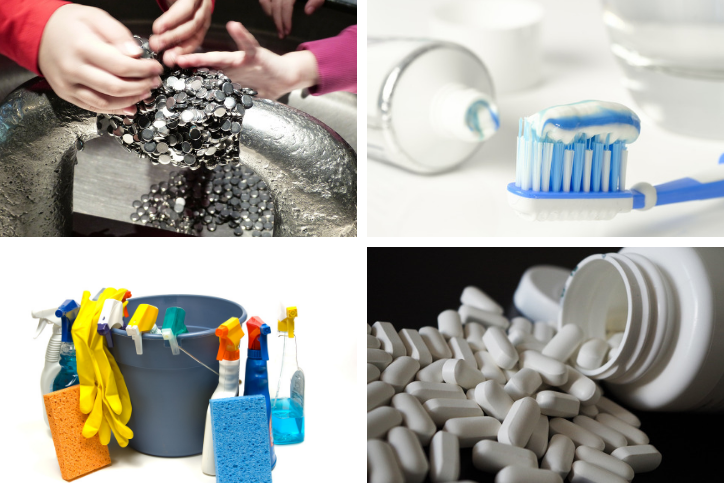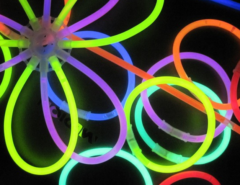Poison centers are open 24 hours a day, seven days a week to help people of all ages. Our specially trained pharmacists and nurses can answer questions about many different substances, including medicines, household products, and other chemicals. In 2017, the Maryland Poison Center (MPC) responded to roughly 32,000 calls about exposures in people. Below are the top three exposures for every age group based on the calls we received.
Young Children (6 years and younger)
#1: Cosmetics and Personal Care Products
Cosmetics and other personal care products are found in almost all households. Often, these products are left in plain sight, making it easy for curious young children to get ahold of them. Our specialists responded to calls about a variety of everyday essentials, such as:
- Soap
- Deodorant
- Toothpaste
- Hand sanitizer
- Perfume
Always supervise children when they are near bathrooms, bedrooms, and other areas where these products might be found.

Pictured: A bottle of household cleaner (left) and a bottle of apple juice (right). Would you know which one was which without a label?
#2: Household Cleaning Products
Cleaning products, including bleach, laundry soap, dishwashing soap, and all-purpose cleaners, should be stored out of sight and out of reach of young children. Consider using a cabinet latch as an extra layer of protection. Even “natural” products can be harmful to children. Keep all cleaning products in their original containers. Placing these products in different containers can confuse young children. They may mistake a dangerous cleaner for water or juice. In fact, some drink containers have the same shape, or the substance may be the same color as a cleaner.
#3: Pain Relievers
Most exposures in this age group involve over-the-counter (OTC) pain relievers, but both OTC and prescription pain relievers can be dangerous for young children. These medicines should always be stored up, away, and out of sight. Although most containers have child-resistant tops, they are not childproof. If given enough time, children can open them. Pain relievers may also be left out between doses when children are sick. Remember to lock the cap and store these medicines away after use. Always use the dosing device that comes with the product. Never call a medicine candy or say it tastes like candy, because it can be confusing for young children and lead to them seeking out the medicine.
Tweens (6-12 years)
#1: Foreign Bodies
Similar to young children, tweens play with, and sometimes swallow, objects such as toys, glow sticks, silica gel packs, and coins. If you see tweens with these objects in or around their mouths, educate them that these objects can be unsafe and that they are not to have them in their mouth.
#2: Cosmetics and Personal Care Products
Personal care products and cosmetics, including hand sanitizer, soap, deodorant, and mouthwash, are popular among tweens. These products can be dangerous if they are inhaled, get in the eye, or are ingested. These exposures are often unintentional.
#3: Pain Relievers
As they become more independent, tweens will start to self-medicate. This can lead to innocent mistakes, especially with OTC pain relievers. They may take too much medicine or take doses too close together. Parents should teach tweens about safe OTC medicine use. Read our recent newsletter for more tips.
Teens (13-19 years)
#1: Pain Relievers
Most exposures to pain relievers among teens involve OTC pain relievers. It is important that parents and guardians discuss safe use of these medicines with children. While we sometimes receive calls about teen exposures to opioids, that number has decreased over the years. This decrease is likely due to better prescribing practices, as well as parents becoming more educated about the dangers of these medicines.
#2-3: Antidepressants, Sedatives, and Antipsychotics
Antidepressants, sedatives, and antipsychotics are commonly prescribed to teens. Because the reasons for these exposures are very similar, we have chosen to list these medicines together here. Stressors like peer pressure, school assignments, and arguments with parents or friends may lead to teens trying to hurt themselves intentionally. If your teen is taking these types of medicine, offer your assistance. Make sure they know they can come to you if they have questions or if they think they have made a dosing error.
Adults (20-59 years)
#1: Pain Relievers
We start to see a change in pain reliever exposures as people reach adulthood. In 2017, we received an almost equal number of calls for OTC pain relievers and opioid-containing pain reliever for this age group. If you are concerned about becoming dependent on a pain medicine, talk to your doctor or pharmacist about other options that may work for you.
#2: Sedatives, Hypnotics, and Antipsychotics
The most common exposures reported were for prescribed anxiety, sleep, and psychiatric medicines. Some of the calls that we received were for therapeutic errors (double doses, wrong medicines taken, etc). Other calls involved people misusing these medicines in suicide attempts and substance abuse. It is important to use these medicines exactly as directed on the prescription label. Discuss side effects and any other concerns you are having with your doctor before changing the way you take the medicine.
#3: Stimulants and Street Drugs
Most of the calls that we receive for this exposure involve illegal street drugs such as heroin, cocaine, and marijuana.
Older Adults (60 years and older)
Older adults account for 8% of calls to poison centers nationally, but make up 20% of all deaths recorded by poison centers. Almost all exposures in older adults involve commonly prescribed medicines. Usually these calls involve therapeutic errors where the older adult took a double dose, mixed up their medicine, took their doses too close together, or couldn’t remember if they took their medicine so they took another dose. For older adults who take multiple medicines, our medicine tracker is a useful tool to help ensure that you take the right dose at the right time. Download the medicine tracker here.
#1: Heart Medicines
For some heart medicines, an unintended double dose may require a visit to the hospital. If you think you might have made a dosing error, or if you can’t remember whether you took your medicine or not, call the poison center at 1-800-222-1222 right away. Do not wait for symptoms to call for help.
#2: Pain Relievers
Read the label for any pain reliever you take. Follow the dosing directions exactly. Both prescription and OTC medicines can be harmful if not used correctly. Some OTC pain relievers might have the same ingredients as prescription pain relievers. Ask your doctor or pharmacist what OTC products you can safely use with your prescribed medicines.
#3: Sedatives, Hypnotics, and Antipsychotics
Sedatives, hypnotics, and antipsychotics can cause falls in seniors, even when used as prescribed. Carefully follow the dosing directions for these medicines.
As you can see, substances and reasons for exposure can differ greatly by age. But, the poison center is available to help everyone with free and confidential advice. Do not wait for symptoms to show if you suspect a poisoning or overdose. Call our specialists at 1-800-222-1222 right away. For more information about calls to the MPC in 2017, check out our annual report.





Leave a Reply